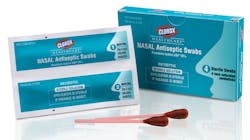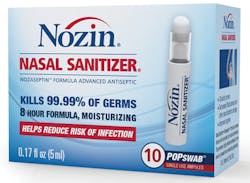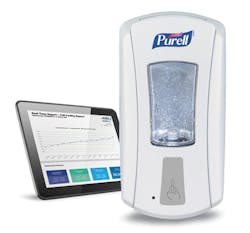It’s not a hoax. Antimicrobial resistance (AMR) is real — has been for decades — and it’s getting worse.
The Centers for Disease Control and Prevention (CDC) estimates that 23,000 people die from 17 types of antibiotic resistant infections each year, with an additional 15,000 deaths attributed to Clostridium difficile (C.diff.), a ubiquitous and hard-to-treat infection that in many cases has been linked to disrupted gut flora caused by overuse/misuse of antibiotics. But these numbers could be wrong. Unfortunately, the death and morbidity rates attributed to drug-resistant infections could be much higher than the record shows. A recent Reuters investigation revealed that the current data is woefully inaccurate, that numbers are based on small samples collected from 10 or fewer states each year, and do not include statistics from heavily populated areas such as Florida, Texas, New York City and Southern California. The report also contends that government agencies lack the “political, legal and financial” muscle needed to enforce the kind of surveillance that would compel greater transparency. As a result, most healthcare facilities haven’t been completely honest about the problem — because they don’t have to be.1
A call to action … still
While the number of actual infections and deaths linked to drug-resistant pathogens may be fuzzy, what we do know is that the list of hard-to-treat infections and diseases is growing; and experts are urging fast and aggressive action or we risk facing a point of no return. Where common illnesses become altogether untreatable and lifesaving surgical procedures — joint replacement or heart surgery, for example — are as risky and dangerous to undergo as jumping from a plane without a parachute.
“If we lose the ability to use antibiotics to treat infections, so many things about healthcare that we take for granted change overnight,” said Dr. Michael Bell, MD, Deputy Director, Healthcare Quality Promotion, CDC, to a large crowd of healthcare professionals during the September 2016 AHE Exchange Conference in Pittsburgh. “Right now, if I’m hit by a truck, someone will scoop me up, the EMTs will try and save my life until a trauma surgeon gets there and they will give me antibiotics because there’s poop, there’s road grit, there’s whatever, and it will cause an infection. If we can’t treat that infection, then trauma surgery as we know it is history.”
Medical researchers, in an impassioned call to the medical community for better stewardship and development of new antibiotics, published in Clinical Infectious Diseases, said “Antimicrobial effectiveness is a precious, limited resource. Therefore, preserving antibiotic effectiveness can be viewed similar to society’s responses to overconsumption and depletion of other precious, limited resources, such as oil and other energy sources, clean water and air, and forests.”2
That was nearly nine years ago.
Last year the White House released its National Action Plan for Combating Antibiotic-Resistant Bacteria (CARB), calling for a 50 percent reduction in inappropriate outpatient antibiotic use in hospitals by 2020. In June of this year the Centers for Medicare and Medicaid proposed rules that would require hospital-wide infection prevention and control and antibiotic stewardship programs solidly in place.3 Even the United Nations General Assembly — for the first time ever — placed antimicrobial resistance on the agenda this year, urging immediate and collaborative action across the globe.4
There are plenty of examples demonstrating the need to move. Yet, even though the calls grow louder and the pressure intensifies, too many healthcare facilities still struggle to implement solid antimicrobial stewardship programs (ASPs). In fact, the ECRI Institute put inadequate antimicrobial stewardship on its 2016 list of top patient safety risks. Results from the latest National Healthcare Safety Network (NHSN) Annual Hospital Survey backs it up with some notable numbers, namely that less than 40 percent of all hospitals have a program in place that meets the CDC’s Core Elements for hospital ASPs.5
And for those without a strong ASP culture, it’s often business as usual.
“CDC studies have demonstrated that 30 to 50 percent of antibiotics prescribed in U.S. hospitals are unnecessary or clinically incorrect,” said J. Hudson Garrett, PhD, MSN, MPH, Global Chief Medical Officer at Pentax Medical.
It doesn’t have to be this way. ASPs, when implemented properly, can be quite effective. The CDC’s Core Elements of Hospital Antibiotic Stewardship Programs states “evidence demonstrates that hospital based programs dedicated to improving antibiotic use can both optimize the treatment of infections and reduce adverse events associated with antibiotic use.”6 The medical researchers who analyzed the NHSN Hospital Survey concur. “Comprehensive ASPs can be established in facilities of any size and hospital leadership support for antibiotic stewardship appears to drive the establishment of ASPs,” said the authors in the August 2016 journal Clinical Infectious Diseases.2
“Facilities accredited by the Joint Commission (TJC), should already be on board as the TJC has approved new antimicrobial stewardship standards that will become effective on January 1, 2017 for hospitals and critical access hospitals,” said Vicki G. Allen MSN, RN, CIC, FAPIC, Infection Prevention Director at CaroMont Regional Medical Center in Gastonia, NC. Allen is also Vice Chair of the Communications Committee at the Association for Professionals in Infection Control and Epidemiology (APIC). “If hospitals don’t already have a program in place, it will be a challenge to get one in place, however, there are plenty of toolkits and guidelines available to help facilities get an antimicrobial stewardship program implemented,” she said.
Leadership is essential
Successful ASPs do require a steady, concerted effort and dedication from everyone, but it starts with a serious investment from those in the top tier.
“Healthcare C-Suite executives, chief medical officers, infection preventionists, infectious disease specialists, and other healthcare facility leaders all play a critical role in building a sustainable antibiotic stewardship program,” Garrett said. “The presence of C-Suite leadership commitment sets the stage for accountability throughout the entire organization, and ensures that the stewardship program is properly resourced with people, time, and money to achieve the goals. It is also helpful to encourage a culture of transparency with results towards the program target by sharing both positive and negative outcomes with all associated stakeholders, including frontline staff and clinicians.” Visit https://hpnonline.com/13000326 for Dr. Garrett’s HPN online exclusive “A primer on antibiotic resistant superbugs and improving antibiotic stewardship.”
Hong Lam, Director of Quality and Clinical Services, PipelineRx, says clear and consistent communication is imperative to success. “Drug usage and monitoring is often a pharmacy issue; the ASP has to go beyond the walls of the pharmacy department,” she said. “ASP is not for cost containment or related to some quality improvement that only needs the attention of a few. Communication of what it is and facility goals for ASP need to be known, they require participation of all the staff and the message needs to be continuous. Also, ASPs tend to focus on the in-patient setting since this is where the sickest patients are and where the most antimicrobials are being used. This is a good start but an ASP should also expand its activities to ambulatory surgery centers, dialysis centers, nursing homes, long term care facilities and the ER.
“Assess what endpoint or goal is important and do an assessment of it before ASP and after — but pick realistic, measurable goals,” Lam continued. “Narrow them to a few primary and secondary goals. If a facility is starting ASP, positive reinforcement in a form of goals achievement can be the difference between success and failure. Often a facility picks too many goals at the start of the program that lead to an increase in resource requirements, loss of primary focus and staff engagement.”
Tools to support ASP goals
Kevin Jones, Vice President of Pharmacy Services at PipelineRx, offered some examples of how the company can help hospitals remain compliant with established prescribing and dosing guidelines and other ASP protocols. “PipelineRx collects data regarding the number of interventions performed by the PipelineRx staff and reports the intervention data to its clients each month,” he said. “The data includes the number of interventions completed and estimated value of the interventions. PipelineRx pharmacists can develop ASP guidelines, assist in creating antibiograms, complete daily reviews of microbiology results and enforce prescribing guidelines with physicians. PipelineRx staff can provide remote medication order processing during the normal hours of operation by the on-site pharmacy staff to allow the on-site pharmacists to focus on the development, implementation and on-going maintenance of clinical programs such as an ASP.”
Cardinal Health’s antimicrobial analytics program is another solution that can help facilities identify and rectify inappropriate use of antibiotics. Kate Shea, PharmD, BCPS-AQ-ID, Clinical Director, Infectious Diseases, Cardinal Health Clinical Quality Services Department, explained that the process begins with a four-phase assessment: regulatory, support and program foundation, empiric antibiotic selection and basic tracking/reporting, and streamlining and advanced tracking/reporting.
“We use these phases to identify gaps and provide a customized analysis and plan,” said Shea. “The Cardinal Health antimicrobial analytics program provides a tool to track antimicrobial utilization and compare against the specific hospital’s baseline, as well as the Cardinal Health hospital network benchmark. The most common opportunity identified through the Cardinal Health antimicrobial analytics program is optimization of appropriate use of broad spectrum antibiotics. Two common examples of identified opportunities are with broad spectrum agents such as the carbapenem class and daptomycin. A healthcare system we worked with had both of these agents identified as having utilization (e.g., days of therapy per 1,000 patient days) above the Cardinal Health benchmark indicating a potential opportunity to optimize appropriate use.”
After implementing the program, Shea said the facility’s utilization of those dugs decreased approximately 40 percent with savings of 45 percent (carbapenem ) and 25 percent (daptomycin).
“Many facilities that have demonstrated substantial improvements in inappropriate antibiotic prescribing have worked aggressively with colleagues in information technology as well as external electronic medical record (EMR) vendors to create custom modules in the patient’s chart that encourages better prescribing practices, monitors a patient’s total consumption of antibiotics and can provide intelligence to the provider about potential risks as well as the most appropriate “Drug-to-Bug” match for the suspected or confirmed microorganism,” Garrett added. “The use of advanced laboratory methods to rapidly detect the presence of superbugs in the patients can improve mortality and morbidity. These results must be integrated directly into the patient’s medical record with the ability to instantly alert the provider and healthcare team about critical results.”
Richard Lowe, PhD, MPH, Senior Scientist for Clorox Healthcare, pointed to a study that showed a variety of reasons why ASPs can be difficult to implement. “The ERASE Clostridium difficile Project, a mixed-methods study designed to evaluate the implementation and impact of antimicrobial stewardship programs in six hospitals, showed that implementation was more complicated, more challenging and took longer than expected,” Lowe said. “In addition to identifying interventions such as which antibiotics to target, it was essential to gain approval from diverse stakeholder groups, secure information technology support, get buy-in from prescribers, and educate widely to achieve reductions in antibiotic usage. Each hospital also had to tailor stewardship protocols based on their unique staffing, resources, existing practices and culture.7
“Implementing stewardship programs can be challenging and take a long time, but there are a few simple steps that facilities can take to optimize existing protocols to help improve antibiotic stewardship and prevent the spread of antibiotic resistance now,” Lowe continued. “One is the use of an antiseptic instead of an antibiotic for nasal decolonization prior to surgery. Using an antiseptic, like Clorox Healthcare Nasal Antiseptic Swabs instead of an antibiotic for nasal decolonization is a simple way for any healthcare facility to reduce unnecessary antibiotic use. The swabs are highly effective and in an in-vitro study have been shown to reduce Staphylococcus aureus by 99.4 percent after one hour and 99.99 percent after 12 hours, making the use of the antiseptic swab a simple way for facilities to improve antibiotic stewardship.”8
Global Life Technologies Corp., manufacturer of Nozin products, is another company offering an antiseptic solution. John Willimann, President and Chief Science Officer, also shared his view.
“Complicating stewardship is the fact that recent studies have demonstrated outcome benefits with the prophylactic administration of antimicrobials. Balancing the risk associated with prophylactic antimicrobial use against the outcome benefit (fewer HAIs) is one of the biggest challenges facing healthcare providers today,” said Williman. “Fortunately, non-antibiotic, antiseptic solutions designed for infection control to reduce bacterial burden have emerged as a standard of care. Research in infection control supports the benefits of decolonization to reduce HAI in the OR, ICU and other high risk areas. Nozin Nasal Sanitizer antiseptic is clinically proven to reduce Staph aureus nasal carriage by 99 percent without use of iodine or antibiotics. Nozin Nasal Sanitizer is a safe, effective and non-antibiotic way to accomplish and sustain nasal decolonization.”
Willimann said healthcare facilities are having success with the product.
“Brian Kendler, RN, CIC, Infection Preventionist at Marshall Medical Center, CA, said, ‘As an antiseptic and not an antibiotic, the Nozin product conforms to the goal of our antibiotic stewardship directives. Our patients really like the Nozin product as evidenced by use compliance and the increased satisfaction that we have heard since implementation.’ In lieu of mupirocin antibiotic, Nozin nasal antiseptics are being used for patients perioperatively, not just in pre-op, as well as for ICU and other high risk patients who are susceptible to pathogens. Facilities such as Marshall are eliminating contact precautions associated with MRSA colonization while saving money, time, improving care and conforming with antibiotic stewardship initiatives. There is also a trend towards nasal decolonization by staff to help reduce environmental burden around the patient.”
Jim Arbogast, PhD, Vice Hygiene Sciences and Public Health Advancements, GOJO, reminded also that consistent and proper hand washing is a simple, yet critical, ASP component. Unfortunately, it is still widely ignored by those who work and visit hospitals and other healthcare settings. “We need to widely deploy prophylactic solutions that prevent the need for antibiotics and therefore reduce the burden of resistant organisms across communities and healthcare settings,” said Arbogast. “One prevention approach to reduce the need for antibiotics is effective hand hygiene. As we know, hand hygiene is one of the best measures you can take to prevent the spread of illness-causing germs. GOJO supports the CDC “Get Smart” programs9 with media efforts in a very deliberate, multi-year effort, to raise awareness of hand hygiene as a preventive measure to reduce health risks from antibiotic resistance, targeting healthcare and public health leaders, educators and parents.”
They also offer the GOJO SMARTLINK Hand Hygiene Solution, an electronic compliance monitoring platform with clinician-based, on-site support, advanced hand hygiene formulations and dispensing systems, and technology that accommodates monitoring at a group, individual, role, and area level.
“Besides the obvious and most important factor, that of patient safety, financial savings for the patient and healthcare organizations can be significant,” said Allen. “CaroMont Regional Medical Center has been successful in decreasing the incidence of C. diff infections through focused surveillance on the appropriate ordering of specimens in an effort to rule out inappropriate testing as well as patients who may be colonized. They also collaborate with physician clinics and nursing homes outside of the hospital setting to review community onset events for C. diff and other multidrug-resistant organisms and offer education and information to their staff to help in the prevention of antimicrobial resistance. An effective ASP most assuredly helps healthcare personnel improve the quality and safety of patients.”
Engaging EVS
Speaking to a group of Environmental Services professionals at the 2016 AHE Exchange Conference in late September, Garret urged EVS department managers to also be strategic and proactive in the effort to fight resistance. “Just using a disinfectant alone is not enough,” he said. “You need to become an expert in it, you need to become an expert in how it’s used, why it’s used, when it should be used and how you need to match it up with your facility’s microbiom — your bugs that you see in your hospital matched up with the antimicrobial agents that typically are effective. You can use that as a tool to make sure you’re selecting the right types of antimicrobials, whether its hand hygiene or surface disinfectants in your facility. So it makes a big difference.”
Garret also encouraged conference attendees to get more involved in understanding and even facilitating healthcare research. “Research typically sounds like it is a scary term because people say ‘Oh I don’t have time for that, I don’t know how to do that — I don’t do statistics.’ You don’t have to do it all. Partner [with other departments],” he said. “Imagine if you found one thing a year that worked and then you replicated it in another unit. And then you replicated it in another hospital in your system. You’re like, this is actually working. And then you published it and you shared it with AHE — you presented it at this conference and then you put it in a journal and then guess what? The CDC says ‘Wow, that’s a really great thing; we should put that in a guideline.’ Imagine what you did. One unit, one patient, one Environmental Services worker, one time, and it influenced change tremendously.”
For more information about ASPs Allen suggested the following resources:
- Center for Disease Control and Prevention’s Get Smart for Healthcare: Know when antibiotics work: http://www.cdc.gov/getsmart/healthcare/implementation/core-elements.html
- Society for Healthcare Epidemiology of America: https://www.shea-online.org/topic/antimicrobial-stewardship
- Infectious Diseases Society of America: https://www.idsociety.org/New_Antimicrobial_Stewardship_Guideline_2016/
- Society of Infectious Diseases Pharmacists (offers a course in ASP for pharmacists): http://www.sidp.org/page-1442823.
References
- Reuters; The Uncounted; ‘Superbug’ scourge spreads as U.S. fails to track rising human toll; September 7, 20016; http://www.reuters.com/investigates/special-report/usa-uncounted-surveillance/.
- Clinical Infectious Diseases, The Epidemic of Antibiotic-Resistant Infections: A Call to Action for the Medical Community from the Infectious Diseases Society of America; 2008; http://cid.oxfordjournals.org/content/46/2/155.full.pdf+html.
- Centers for Medicare and Medicaid Services. CMS Issues Proposed Rule that Prohibits Discrimination, Reduces Hospital-Acquired Conditions, and Promotes Antibiotic Stewardship in Hospitals; https://www.cms.gov/Newsroom/MediaReleaseDatabase/Fact-sheets/2016-Fact-sheets-items/2016-06-13.html.
- United Nations. Increase in Antimicrobial Resistance Threatening Human Health, Sustainable Food Production, Secretary-General Warns, Urging Swift, Concrete Action; http://www.un.org/press/en/2016/sgsm18107.doc.htm.
- Antibiotic Stewardship Programs in U.S. Acute Care Hospitals: Findings From the 2014 National Healthcare Safety Network Annual Hospital Survey. Clinical Infectious Diseases. May 2016; http://cid.oxfordjournals.org/content/63/4/443.abstract?sid= b1cd6af8-4c83-4eb0-b4ef-116b5b00c6a4.
- Centers for Disease Control and Prevention. Core Elements of Hospital Antibiotic Stewardship Program; http://www.cdc.gov/getsmart/healthcare/implementation/core-elements.html.
- Agency for Healthcare Research and Quality. Developing the Capacity to Implement Antimicrobial Stewardship: Opportunities for the Future; http://www.ahrq.gov/professionals/quality-patient-safety/patient-safety-resources/resources/advances-in-hai/hai-article10.html.
- In vitro Clorox Technical Services; Clorox Study #9550-005.
- Centers for Disease Control and Prevention. Get Smart About Antibiotics Week; https://www.cdc.gov/getsmart/week/.
About the Author

Valerie J. Dimond
Managing Editor
Valerie J. Dimond was previously Managing Editor of Healthcare Purchasing News.







